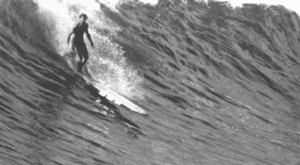The Enduring Legacy of Surfing in Ocean City, New Jersey, The First Swells: Hawaiian Roots and Early Adoption (Early 1900s – 1950s)
Ocean City, New Jersey, harbors a surprisingly deep and vibrant history within the dynamic world of East Coast surfing. Far from being a mere recreational pastime, surfing in Ocean City has evolved into a cornerstone of its cultural identity, meticulously shaped by pioneering spirits, concerted community efforts, and the ever-changing, often challenging, dynamics of its unique coastal environment. This series delves into the rich narrative of Ocean City’s surf scene. We will trace its origins from early, influential exhibitions to its modern-day status as a thriving and resilient surf community that has carved out a significant role in East Coast surfing.
The Duke’s East Coast Influence (1912)
The formal introduction of surfing to the East Coast, and by direct extension, Ocean City, can be definitively traced back to the legendary Hawaiian Olympic swimmer and revered “Father of Modern Surfing,” Duke Kahanamoku. In 1912, fresh off his Olympic gold medal victory, Duke conducted groundbreaking surf and swim demonstrations in nearby Atlantic City at the iconic Steel Pier. Kahanamoku, born in Honolulu in 1890, grew up near Waikiki Beach, where he honed his exceptional swimming and surfing skills, eventually becoming a five-time Olympic medalist.His demonstrations were part of a global effort to popularize the ancient Hawaiian sport of surfing.
While these pivotal demonstrations were not held directly on Ocean City’s shores, Duke’s visit is widely credited with having “spread the gospel of surf” throughout the entire New Jersey region, profoundly inspiring early enthusiasts and laying the foundational seeds for the sport’s eventual adoption in Ocean City. This moment highlights that the earliest spark for surfing in the Ocean City region was not an indigenous development but a direct cultural import from Hawaii. This profound interconnectedness of global and local surf history, and the catalytic role of cultural exchange, underscores how a single event in a nearby city could ignite a passion that would eventually define a significant part of Ocean City’s identity.
Tom Blake and the Lifesaving Connection (1930s)
Decades later, another pivotal surfing pioneer, Tom Blake, who was deeply inspired by Duke Kahanamoku’s vision, embarked on a tour of the East Coast, showcasing his innovative surfboard designs. During his visit to Ocean City in the 1930s, Blake introduced Beach Patrol Captain John Carey to the burgeoning surfing lifestyle and the intricate art of surfboard shaping. This interaction proved transformative, as Carey subsequently acquired a Blake board, which notably became the first surfboard officially utilized by the Ocean City Beach Patrol (OCBP) for critical ocean rescues in 1934.
This marked a significant and practical early adoption of surfboards for utilitarian, life-saving purposes, predating their widespread recreational use and subtly legitimizing surfing within the community. Surfing’s early integration into Ocean City, therefore, wasn’t solely recreational; it gained initial traction and acceptance through a practical, life-saving utility via the respected Beach Patrol. This dual function likely contributed to its eventual, broader community acceptance and growth. The surfboard, initially a tool for rescue, gradually transitioned into a symbol of sport and culture.
The Pre-1960s Landscape: Scarcity and Pioneering Spirit
Before the vibrant explosion of the 1960s, wave riding in Ocean City remained a nascent and exclusive activity, practiced by only a “handful of surfers”. These early enthusiasts, including local figures such as Bob Harbaugh, Pete Schwenk, John Carey, and Dr. Schwab, were observed with fascination by curious teenagers like John Loeper, who vividly recalled being inspired to take up the sport himself by watching them at 14th Street.
The extreme scarcity of surfboards during this era was a significant barrier to entry for many. Individuals had to ingeniously craft their own or embark on challenging quests to acquire them from distant sources. John Loeper, for instance, famously wrote to renowned California surfer Greg Noll, who dismissively replied that there would “never be waves on the East Coast of the United States” and refused to send a board. This forced local surfers to innovate; Chuck Allison, for example, creatively fashioned his first surfboard in 1962 from a piece of refrigeration foam salvaged after a severe storm. The pre-1960s period was characterized by a pervasive do-it-yourself (DIY) ethos. Rather than hindering, it fostered a uniquely tight-knit, resourceful, and deeply committed pioneering subculture. This foundational resilience laid the essential groundwork for surfing’s future, more widespread growth, despite significant initial barriers. The shared struggle to access equipment and waves created strong bonds among these early wave riders.
